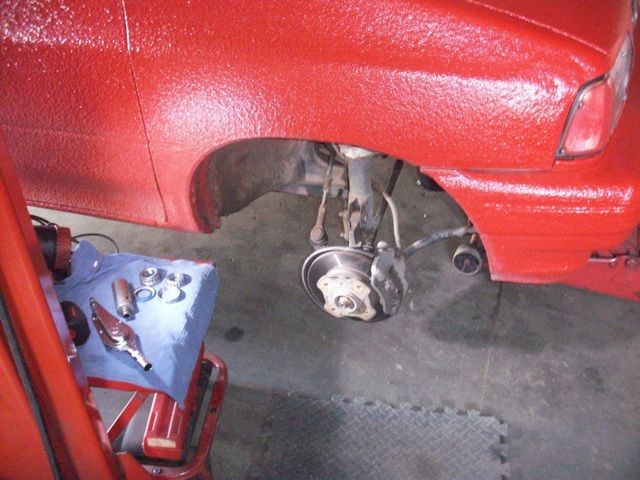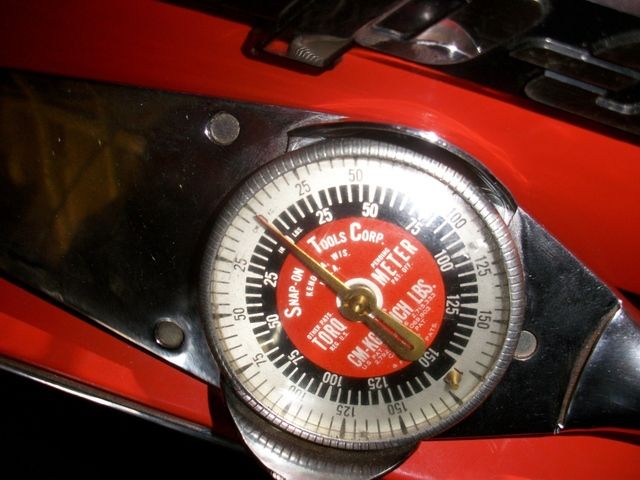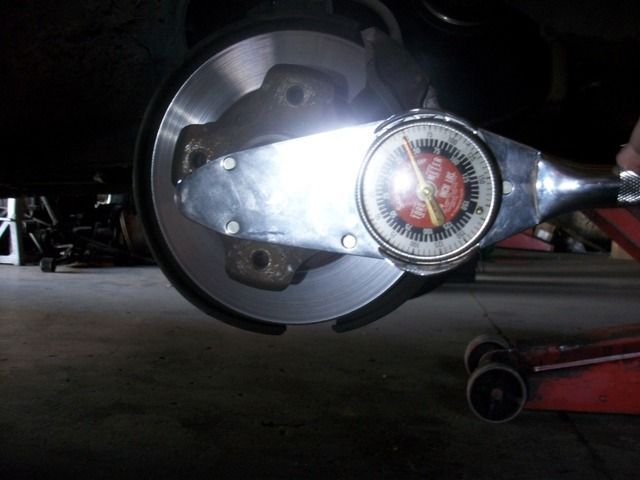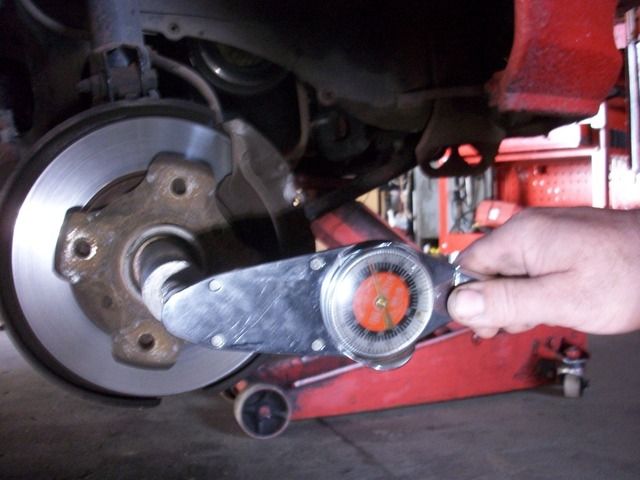Originally posted by 25Horseplay
View Post
Announcement
Collapse
No announcement yet.
Pissed off wheel bearing dealie
Collapse
X
-
I agree. That hub assembly has had the crap beat out of it. I would get another used assembly and start over. There are probably several guys on here that have some hub assemblies laying around that you could buy.You gonna race that thing?
http://www.sdfcomputers.com/Festivaracing.htm
-
Originally posted by crazyrog17 View PostIn fact, I have three you can have if you pick them up!
That is a grand offer for anyone stuck with burnt bearings and having discovered some bonehead has omitted (possibly even yourself) to re-install the spacer. My very first attempt at 'backyard' front bearing replacement wore out at much the same pace as was described earlier. The spacer was still there but must have spun, and wore a tiny bit, along with the inner races which resulted in some play when the again-new bearings went in. But this time I had the local garage press them in place rather than doing the tap-tap routine and preying the tightening of the axle would seat everything.
Comment
-
Another way is to take the front wheel off a junk yard car and use it to replace the assembly you have. Rebuild the junk yard wheel with new bearings and seals, of course. Original owner of silver grey carburetted 1989 Festiva. 105k km as of June 2006. 140k km as of June 2021.
Original owner of silver grey carburetted 1989 Festiva. 105k km as of June 2006. 140k km as of June 2021.
Comment
-
LOL, I gotta learn to keep my mouth shut!!Originally posted by nitrofarm View PostYou mean inch OUNCE,not pounds.
I will try to throw in a few pics to illustrate how this works. In the rest of the
world tapered bearings on a rotating shaft that are adjustable are set up
using inch lbs of torque or the metric equivalent. Here is a pic of all things
back together but the big nut not torqued.

Here is a closer pic of a torque wrench . Both standard and metric are on
the dial.

The next step is to rotate the assembly , read the torque it takes to keep the
assembly turning. Move the dial until zero matches this torque, check it again
to be sure the reading is zero while turning the assembly as shown below.

Now torque the axle nut to specifications or however you do it..
Put the wrench back on and measure the rotating torque. The new reading
will be how many inch pounds of torque your bearing is preloaded. Hear we
have a reading shown below.

A word of caution, it is important to subtract the static torque or obviously
the reading will not b correct. It is also important to NOT use break-away torque to start the assembly rotating. This break-away torque will always
be significantly higher than the rotating torque. Break-away torque shown
below.
 Reflex paint by Langeman...Lifted...Tow Rig
Reflex paint by Langeman...Lifted...Tow Rig

Comment
-
Yep your right Fest.Keep the knuckle with the spacer. Hubs are interchangable. Axle butts up against the bearing when we torque the axle nut. Sorry for the mislead.Originally posted by FestYboy View Postok, one: how on gods green earth does one install a bearing backward!!??
and two: the spacer is matched to the KNUCKLE, not the hub. the hub has no machining spec other than the OD that should be a ~.003" interferance fit to the bearing ID.Last edited by nitrofarm; 05-13-2012, 03:08 PM.Some people like to read fiction,I prefer to read repair manuals. Weird I know-
Henry Ford: "Failure is the opportunity to begin again more intelligently"
Fuseable Link Distribution Block repair link
Comment
-
The only problem with this Movin is the running torqued called out for. Is measured with "Oiled" bearings & no seals installed. And the max is 12 in oz. Which is featherlite. I purchased a Parker torque wrench for this. And I've found that it best for me to set the preload all the way to the top of the tolerance scale ( 12 inch oz ) I think the low side is like 2 inch oz? (Dont have the book in front of me) But I tried setting the preload to that low side. And the preload was much to loose. But it also could be my torque wrench.Originally posted by Movin View PostLOL, I gotta learn to keep my mouth shut!!
I will try to throw in a few pics to illustrate how this works. In the rest of the
world tapered bearings on a rotating shaft that are adjustable are set up
using inch lbs of torque or the metric equivalent. Here is a pic of all things
back together but the big nut not torqued.

Here is a closer pic of a torque wrench . Both standard and metric are on
the dial.

The next step is to rotate the assembly , read the torque it takes to keep the
assembly turning. Move the dial until zero matches this torque, check it again
to be sure the reading is zero while turning the assembly as shown below.

Now torque the axle nut to specifications or however you do it..
Put the wrench back on and measure the rotating torque. The new reading
will be how many inch pounds of torque your bearing is preloaded. Hear we
have a reading shown below.

A word of caution, it is important to subtract the static torque or obviously
the reading will not b correct. It is also important to NOT use break-away torque to start the assembly rotating. This break-away torque will always
be significantly higher than the rotating torque. Break-away torque shown
below.
 Last edited by nitrofarm; 05-13-2012, 03:10 PM.Some people like to read fiction,I prefer to read repair manuals. Weird I know-
Last edited by nitrofarm; 05-13-2012, 03:10 PM.Some people like to read fiction,I prefer to read repair manuals. Weird I know-
Henry Ford: "Failure is the opportunity to begin again more intelligently"
Fuseable Link Distribution Block repair link
Comment
-
Nitro, I have never heard of those specifications or that tool ! I am always interested
in learning new stuff...?!
I will post a pic of this out of my manual, but note that what I do bypasses all the
steps but takes an accurate reading of just the inch pounds of rotating torque..increase
no other parts are included in that reading. I do it this way when I am confident
the shim is correct and will be left there.
It can also be used to accurately check specs with out disassembly.
anyhow the pics of my tool in use are above, here is a pic of the specs
 Reflex paint by Langeman...Lifted...Tow Rig
Reflex paint by Langeman...Lifted...Tow Rig

Comment
-
If everything is new, like after a wreck I try to hit the 12 inch pounds. The more used
parts present the more I head to the middle range. If just checking a used assembly I like to see something above the lowest...Like after a wreck and the insurance specs out
used parts assembly.Reflex paint by Langeman...Lifted...Tow Rig

Comment
-
I'm an idot for some reason I had in oz in my head. Here is the parker wrench I refered too. Sorry for the cheesey music in the background.Originally posted by Movin View PostIf everything is new, like after a wreck I try to hit the 12 inch pounds. The more used
parts present the more I head to the middle range. If just checking a used assembly I like to see something above the lowest...Like after a wreck and the insurance specs out
used parts assembly.
[IMeG]http://i1202.photobucket.com/albums/bb363/nitrofarm/th_hubsetup_00-1.jpg[/IMG]Last edited by nitrofarm; 05-13-2012, 07:45 PM.Some people like to read fiction,I prefer to read repair manuals. Weird I know-
Henry Ford: "Failure is the opportunity to begin again more intelligently"
Fuseable Link Distribution Block repair link
Comment
-
Movin: I wonder about that technique because when I replaced my bearings and torqued the axle nut the wheel was really stiff until I put the tire back on a drove up and down the driveway. Seems the weight of the car seats the bearings? How would I compensate for that in the test?Last edited by WmWatt; 05-14-2012, 11:55 AM.Original owner of silver grey carburetted 1989 Festiva. 105k km as of June 2006. 140k km as of June 2021.
Comment
-
If you are pressing the bearings in with the big nut you will have toOriginally posted by WmWatt View PostMovin: I wonder about that technique because when I replaced my bearings and torqued the axle nut the wheel was really stiff until I put the tire back on a drove up and down the driveway. Seems the weight of the car seats the bearings? How would I compensate for that in the test?
drive it to seat the bearings, then loosen the big nut and get your static
drag reading , tighten the nut again and measure your total. Subtract
the static to read your actual preload.
The tools are supposed to get things seated but sometimes a little
massaging with an air hammer or big dead blow on the knuckle and shaft end can seat them too. If there is any doubt a test drive would be best.
Again, this is a quickie for when you are confident the spacer is correct,
you want to check a used assembly, You just replaced bearings and are
reusing the spacer, that kind of thing. To guess at new shims and use
this to check specs would be no quickie!!
Thanks for bringing up stubborn bearing seating!Reflex paint by Langeman...Lifted...Tow Rig

Comment
-
WmWatt I've experienced the same thing. You prolly are doing this already,but just in case-Originally posted by WmWatt View PostMovin: I wonder about that technique because when I replaced my bearings and torqued the axle nut the wheel was really stiff until I put the tire back on a drove up and down the driveway. Seems the weight of the car seats the bearings? How would I compensate for that in the test?
Make sure as you are torquing the nut. You are spinning the wheel/hub. It will help.
PS dont forget about seal friction/drag.Last edited by nitrofarm; 05-14-2012, 12:32 PM.Some people like to read fiction,I prefer to read repair manuals. Weird I know-
Henry Ford: "Failure is the opportunity to begin again more intelligently"
Fuseable Link Distribution Block repair link
Comment
-
I'm just a "minnow swimming in your wake" Your at the top of the food chain. And I'm just hoping to get some of your crumbs. Trust meOriginally posted by Movin View PostI am pretty bad when it comes to hearing it was a silent movie to me!
Dude, you got some awesome tools!!! We should do an album of cool
tools!!
Q= How far are you seating your seals on the inner/outer? I'm really staring to second guess my thought process on these.droolSome people like to read fiction,I prefer to read repair manuals. Weird I know-
Henry Ford: "Failure is the opportunity to begin again more intelligently"
Fuseable Link Distribution Block repair link
Comment

Comment